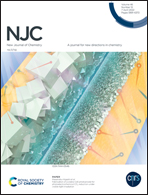Engineering of the structural and morphological characteristics of MWCNTs employing a nano-dimensional binary oxide coating with enhanced thermal oxidation resistance properties for the tailoring of their reinforcement potential†
Abstract
The present investigation demonstrates the rational design of a novel nano-hybrid architecture deploying the stable hybridization of inorganic MgAl-binary oxide nanoparticles with multiwalled carbon nanotube (MWCNT) structures via a strategic and realistic processing scheme, which in turn resulted in distinguishable core–shell morphological features. Herein, the critical alteration of the surface chemistry of the carbonaceous network and the variable incremental alteration of the oxide loading concentration act as key controllable factors promoting the conformal deposition and stable assembly of an inorganic binary oxide shell network at an interfacial position, with a consequent enhancement of the thermal stability of the nano-hybrid architecture. The detailed structural evolution of the core–shell nano-hybrid structure and its key characteristic features have been verified in detail via TG-DTA, FTIR, XRD, Raman, SEM, TEM/SAED, and XPS analysis. It has been observed that thermal treatment at a suitable temperature readily induces a stable passivation layer of inorganic MgAl-binary oxide thin film with a thickness of ∼30 nm, which strongly assists the structural reorganization of the core MWCNTs in a positive way, thereby strongly preserving the shape, purity, and structural integrity of the inner CNTs under harsh environmental conditions. Finally, the present investigation provides a detailed mechanistic view unveiling the structure–property relationship, explaining the thermal oxidation stability and exploring the reinforcement potential of the nano-hybrid structure on the macroscale.



 Please wait while we load your content...
Please wait while we load your content...